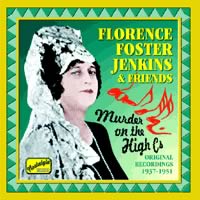Florence Foster Jenkins & Friends on Naxos
|
Ethelbert Nevin [September 2003.] A friend recently confessed he had no CD player. “But you have a computer,” I responded. “Yes,” he said. “And it’s a new computer, right?” “Yeah, got it last year,” he replied, wondering where I was going with my questions. “Well, if it’s a new computer, it probably comes with a CD player,” I insisted. It turned out he’d been using the computer’s CD tray as a cup holder. Delighted by the discovery that he did actually have a CD player, he went out and bought a set of desktop speakers. A silly investment, if you ask me. His computer’s fan sounds like a pencil sharpener.
To stimulate the growth of his nascent CD collection, I got him a disc from Naxos’ Nostalgia Series, Florence Foster Jenkins & Friends (Naxos 8.120711). He wasn’t quite sure what to make of it. I told him I narrowly missed attending her sold-out Carnegie Hall debut on October 25, 1944. It didn’t occur to him that I hadn’t been born yet. He was transfixed by Ms. Jenkins’ “Queen of the Night” aria from Mozart’s Magic Flute. He’d never heard anything quite like it. “Like a hyena caught in a washing machine! It sets all my commemorative plates a-rattle. Her intonation has the accuracy of toddlers solving quadratic equations.” He was astounded to learn that the unflappable Ms. Jenkins was capable of making such a recording in just one take, and that microphone placement, acoustics, rehearsal, and any preparation were beyond the scope of her interests. The exemplary notes tell us that Ms. Jenkins’ recording was a best seller in its day, cited by Time Magazine (June 16, 1941). Ms. Jenkins appears in nine selections on this disc, one more than on RCA’s release (09026-61175-2). “Valse Caressante” will be the new thrill for Ms. Jenkins’ fans, 6:25 of subtle stylings accompanied by piano and flute. It’s hard to listen to more than a few of these at a sitting, but we played the disc several times in succession, switching off the overhead fluorescent lights so that their background hum would not intrude. We even unplugged the rock-polishing machine. Adele’s Laughing Song from Strauss’ Die Fledermaus was captivating: “Tone like a horse stepping into a bear trap!” The Bell Song from Delibes’ Lakmé: “A drunk tossing pebbles at the side of a barn. The emotional range of a lemon wedge!” And on Ms. Jenkins’ contoured Russian in “Biassy”: “An 18-wheeler downshifting.” He expressed doubt that Ms. Jenkins’ pianist and the composer of two of the songs had the unlikely moniker of Cosme McMoon. I suggested that it might have been a pseudonym, and that if you shift each letter two positions, you get “Equog Oeoqqp.” “Must be Welsh,” he assented. “What about the other people on this disc, Ms. Jenkins’ ‘Friends.’ Who are they?” he asked. “Oh, nobody famous. Just folks with funny names like Alexander Kipnis, John Charles Thomas, Josephine Tumminia, Ezio Pinza, Jeanette MacDonald, Robert Merrill and Lauritz Melchior. Apparently Pinza sang somewhere in the South Pacific.” After some consideration he added, “These singers have a special quality to them, like they could have actually made it big-time. Too bad some of them have such trouble singing in English.” I agreed that hearing Kipnis sing “Little Jack Horner” was excruciating. Melchior belting out “Please Don’t Say No” proved to be an exceptionally arduous experience as well. I neglected to tell him that Jimmy Dorsey and His Orchestra accompany Tumminia (“The Blue Danube”) and that Pinza appears with The Sons of the Pioneers (“The Little Old State of Texas”). But something did catch his attention: “Oh, Jimmy Durante has two songs on this. Why didn’t you tell me? Well, there’s a respectable talent!” In a few months I’ll hunt down a copy of Naxos’ Spike Jones collection (8.120679). It’s not available here in the US, but just to see his reaction, it’ll be worth trekking to Canada to get it.
[More Ethelbert Nevin]
[Previous Article:
Beethoven’s Choral Fantasy and I]
|
